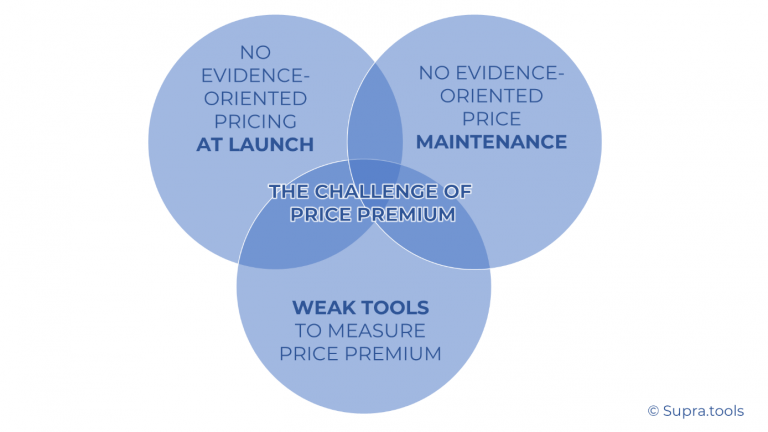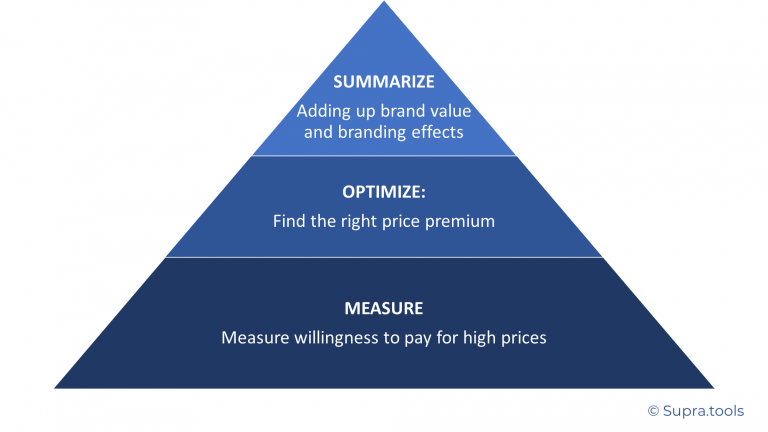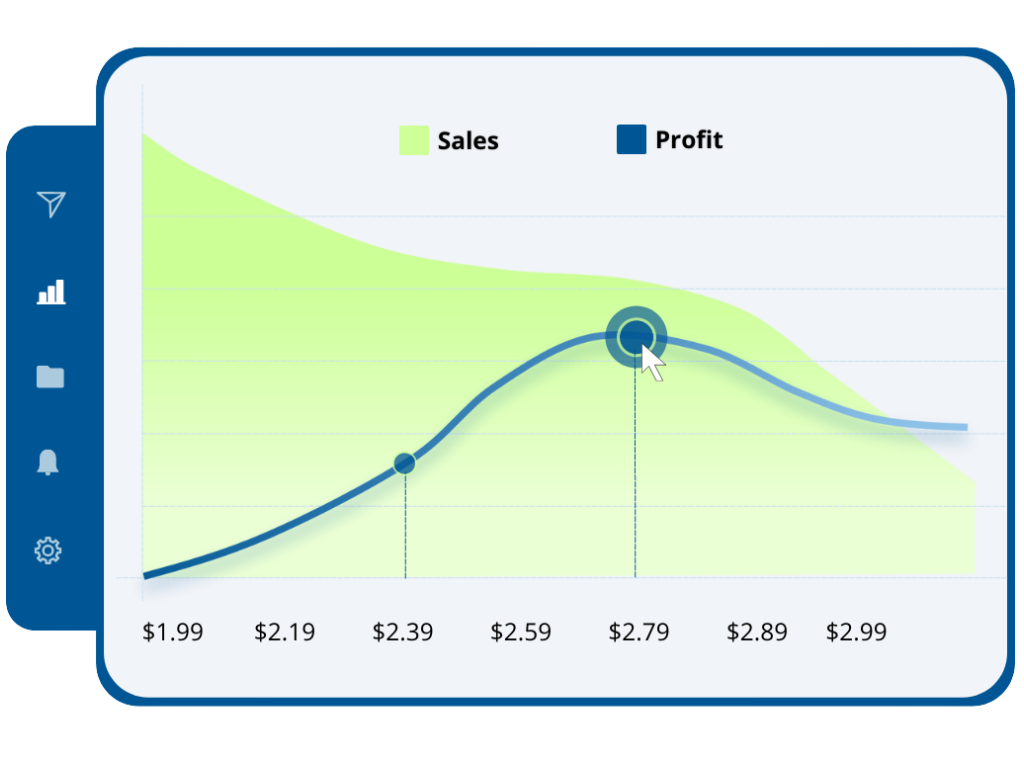June 15, 2022
Premium pricing strategy - The mark-up for your brand


Is it really so difficult? Can’t we just look, apply our price competition strategies and look at the price difference between branded products or luxury products and the comparable no-name product?
Well. Such an approach is better than nothing. But it relies on numerous unrealistic assumptions and can, therefore, quickly lead us astray.

The central fallacy is the assumption that both your branded product or luxury good (developed according to a high-price premium pricing policy) and the comparable no-name product developed according to a low-price strategy is optimally priced and that you are thus exploiting your profit potential in the best possible way. However, this is the exception – for understandable reasons:
Pricing for new products is different from pricing for existing products.
The majority of all new products today (according to the study “State of Pricing 2022“) are not priced on an evidence-based basis.
Major Methodological Weaknesses
If products are priced on the basis of evidence, procedures with major methodological weaknesses are used.
Premium Products are different from being priced than standard market value
Such products that have been optimally priced are usually never analyzed again on the basis of evidence. However, the price optimum depends on premium brand recognition, competitive prices, and many other things, all of which change over time.
The bestselling book „Pricing Intelligence“ has more on the topic and

Some brands, especially a luxury brand in the high-price segment defines itselves as the top premium class, but then have problems enforcing the price associated with it when implementing premium pricing. A higher price does not necessarily mean a higher perception or higher profit margins.
The optimal price increases with higher production costs and higher margins. At the same time, it falls with falling sales, which are associated with a higher price. In some cases, both effects balance each other out for a wide range of values, so that it is not necessarily noticeable in sales that a product has been incorrectly priced by orders of magnitude.
To use a premium pricing strategy is indeed of particular importance for several reasons. Marketing is always suspected of generating only colorful images and great stories but of trying to evade the hard numbers and impact figures.
In order for the CFO and CMO to find a common language, there is no way around a meaningful evaluation of marketing. Marketing usually only generates short-term new customers or upselling gains as a by-product.
The main effect is that customers know the brand, recognize it, consider it and appreciate its value.
Today, the determination of a premium brand is carried out in such a way that surveys are used to determine which proportion of category buyers would basically consider or prefer the product. This consideration leaves price entirely out of the equation and wrongly assumes that the optimal price has been set.
If the value of the brand can be better determined, there are many advantages to be gained:
In the following, I would like to show how it can be done. The goal seems worthwhile. I will show
“Understanding price premium not only helps evaluate your brand – it helps increase it”.

A medium-sized brand for sausage products had become more complex due to strong growth. New vegan product lines and new country markets not only made the entire price management more complex. There were also questions about the extent to which the considerable advertising budgets would pay off and amortize.
The marketing manager was looking for a better way to quantify the value of the brand and at the same time, optimize pricing. Initial attempts applied conjoint analysis to some corner products. The analysis provided an incremental price equivalent.
However, this exercise was costly and yet could not be done for all markets. It also raised questions: A product has a branded higher willingness to pay and thus higher margins. Doesn’t it then make sense to aim for a somewhat lower price in terms of pricing policy? After all, volume increases are particularly worthwhile when margins are high. If you do that, what exactly is the brands value or brand equity really like?
The next year, the decision was made to use an Implicit Intelligence™ measurement of price willingness. This enables a simple, cost-effective and therefore scalable measurement. The methodology provided price-sales function per product. From this, the optimal price and resulting profits with vs. without brand were determined.
All additional brand-related profits were added up. By also discounting future profits, a brand value was obtained.
The company now carries out this measurement annually. The increase of brands value can be interpreted as the result of the marketing investments. After one year, it was clear that the investments were amortised by a factor of 6.
The results allowed only one conclusion, and the marketing budget was significantly increased.
Some professionals prefer to access video tutorials around pricing and insights
In the case study, the so-called MOS process was applied. MOS is a proven process scheme along which CMOs can be guided.

MEASURE – Measuring willingness to pay
Everything stands and falls with measuring the brand effect. The first method suitable for this was conjoint measurement. With the help of artificial choices made within a survey, the downstream analysis determines so-called part worth values for each feature.
In conjoint, products are considered as a feature profile. The brand, as well as the price, are only manifestations of its features and contents. Example: Assume that the difference in utility between a 5 and 6 Euro is equal to “2”. Further, assume that the difference in utility between a brand X and a no-name brand is also equal to “2”. Then this brand X has a price premium of 1 euro (6 minus 5).

Unfortunately, the conjoint method also has some disadvantages (discussed in detail in our article here). Practically, the most serious is that it requires expertise to set up. Conjoint studies are therefore usually costly and time-consuming.
Implicit Intelligence™ methods are an attractive alternative. By analysing reaction times, price attitudes are determined in simple yes/no questions, which are adjusted for various bias effects with the help of artificial intelligence. The result is the sales that can be expected at certain price points.
If we measure this price-sales ratio of a product with a brand and one without, we find out what additional sales the brand can be expected at each price point.
This does not mean that we know the additional price caused by the brand. In reality, this knowledge is only possible through the assumption in conjoint that price and sales have a linear relationship to each other. Unfortunately, this assumption is unrealistic and almost always violated.
Therefore, not only for practical but also for methodological reasons, methods of Implicit Intelligence™ are to be preferred.
OPTIMIZE – Finding the Price Premium
A brand leads to more sales at the same price. However, this additional sales is not the same at every price. Even if it were, the additional margin triggered by it would play a greater role in percentage terms at upper price points.
Since the optimal price is based on the net margin, it depends on the individual case where it is with vs. without a brand.
In the case of products with comparatively high margins and low manufacturing costs, a brand can lead to the optimal price even being lower with the brand. If sales increase very strongly when the price is lowered, this can be optimal in exceptional cases when the margin is higher due to the brand.

Now the effect of the brand can be considered from three points of view
Percentage of additional net profit due to higher sales at the same price.
Percentage of additional net profit due to the higher price that generates the same sales.
Percentage additional net profit resulting from the changed optimum price.
This is because in the rarest of cases it is neither optimal to simply set the price so that the same sales result, nor to charge the same price of the no-name product in order to exploit the quantity effect.
While conjoint logic works according to the margin effect, Implicit Intelligence™ will be used to determine the value of the brand based on the difference in optima.
SUMMARIZE – Adding up brand value and branding effects through advertising
The result of the “difference in optima” method is an additional profit per target customer. The brand value is now obtained by multiplying by the market size. A brand that earns 1€ more per year per target customer (buyers and non-buyers) by adjusting the price brings in exactly 10 million more per year with 10 million target customers. Discounting these cash flows from further years in the future leads to a brand equity estimate, e.g. 50 million.
How can the contribution of marketing in a high-price strategy to the increase in brand value be determined?
The recurring measurement of the willingness to pay and the regular measurement of the brand value derived from it makes it possible to track it.
Like everything, this change is a result of many influences. Growth in overall demand or a change in customer requirements are external effects.
The effects of the individual marketing instruments can be determined in the context of marketing mix modelling by looking at the changing value of the brand over time as a target variable.

Today pioneers use the latest pricing survey tools that use Neuroscience + AI
Interested professionals can use some tools even for free and explore on its own
You can access supra tools free here.
It should be noted that the willingness to pay caused by a brand can NOT be derived from the prices on the market.
Furthermore, the value of the brand is NOT defined by the additional price for the same sales volume. This is because the optimum is usually a higher price which at the same time enables higher sales.

In order to determine the value of brands in the context of developing a high-price strategy, intelligent methods (especially Implicit Intelligence™ for Pricing) are needed to determine the market reaction to prices. The comparison of a low price strategy (Noname) vs. high price strategy (brand) in such measurement provides the data basis to determine the brand equity.
The good thing is that these methods are simple, inexpensive and practicable so that even medium-sized companies can benefit from them.
Admittedly, each product represents an individual optimization case. However, one often finds patterns (“The optimum is a price premium of about 1 euro, which usually also promises 10% additional sales compared to Noname”) that can be applied as a “robust rule of thumb” to the entire product range.
However, this should be checked regularly in terms of tracking and on several products in the product range.
The benefits for marketers are manifold. The value of their work can be measured impressively in monetary terms and at the same time maximized through optimized pricing. At the same time, you kill two birds with one stone.
Very interesting: Companies entering the field of pricing strategies through brand evaluation and price premium measurement can apply for a free strategy session at supra.tools as a service.
If the prerequisites are right, this should usually be feasible at short notice. (Just send a short message to wolfgang@supra.tools)
In my email newsletter “Pricing Insights” I cover the whole range of pricing insights solutions-from Garbor Granger to Conjoint, from NeuroPricing to Pricing Software Systems. I describe the application in various fields from new product pricing to promotion, from brand premium to feature pricing.
Keep up to date here.